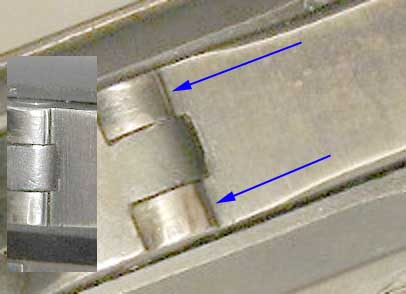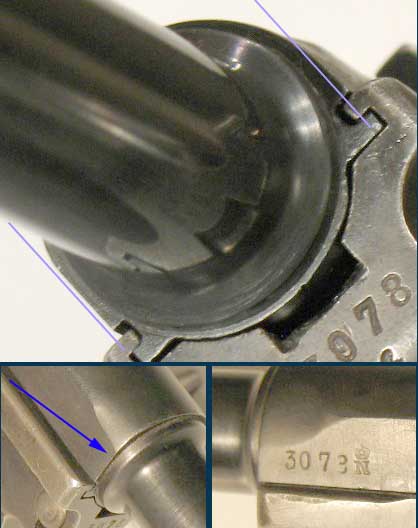Archie,
Thanks very much for the presentation. This is a very interesting Luger, sufficiently so that it deserves a momentâ??s consideration.
On the face of it, this gun appears to be an Alphabet Commercial (formerly known as a 1920 Commercial). It seems to have all the earmarks, primarily a four-digit serial number with suffix, and an upright crown-over-N commercial proof.
The long-held theory abut the origin of this variation is that it is a result of formerly military Lugers being reworked into Commercial weapons in the 1920s, thus explaining the characteristic military-style serial number with letter suffix. Jan Still, in
Weimar Lugers, asserts that the Alphabet Commercial guns were manufactured from new and surplus parts, not scavenged from pre-existing assembled pistols. My own observations and understanding tend to bear this out.
The gun presented here serves double duty, both an example of a military pistol converted to an alphabet-style commercial Luger, and a demonstration of the characteristics which reveal that Alphabet Commercial Lugers are indeed newly manufactured and assembled.
The proof marks on this Luger are indeed upright c/N, placement indicating that the gun underwent test proof in the civilian proof house which serviced DWM, sometime after approximately 1920. The gunâ??s serial number has a b suffix. The Alphabet Commercial variation begins with the i suffix, so the suffix on this Luger is the first indication that closer examination is in order.
The blank front toggle is an invitation to identify this gun as a â??sneak,â? another obsolete variation term for Lugers manufactured by DWM in 1929, and now called 29DWM. These guns have s, t, and u suffixes, and sometimes have front toggle pieces which are blank. These, however, seem to have been assembled into guns without having been stamped with the DWM scroll. Close examination of this gun shows that the top of the toggle piece has been shaved to remove the mark. An uncharacteristic ridge at the front of the toggle piece, pointed out here,

shows how the surface has been lowered from its original profile. Close comparison with an unmodified toggle piece will reveal other differences.
Another characteristic of Commercial Lugers is their hidden serial number placement. This gun has serial number stamps on the left receiver, trigger plate face, and extractor, in military style. This explains the re-stamp of the number on the front toggle pieceâ??this would have been removed along with the toggle logo, and would have been replaced. The toggle piece is likely original to the gun.
As Archie has pointed out, it appears that the right receiver has been worked to remove military proof marks formerly stamped there. In the photo below comparisons with the straight lines superimposed on the receiver front show how the profile of the right receiver is straighter than the left, revealing that material has been removed.

The comparison shots of the left and right receiver demonstrate this further, showing how the right receiver is flattened compared to the left, and the flat area is higher due to material removal.
So, why the c/N, and what was this gun originally?
Germany, like all countires in Europe, has a national proof law. The US does not. Since there is no GERMANY stamp on this gun, it is reasonable to believe that it was reworked for domestic sale and not intended for export.
German proof law requires re-proofing whenever one of the pressure elementsâ??barrel, breechblock, or receiverâ??is replaced. Considering that the regulations under the Treaty of Versailles forbade manufacture of handguns in military calibers (i.e. 9mm) or with barrels four inches or longer, the barrel is the most likely part to have been replaced. However, the barrel on this gun is not the original rework barrel. It is patently more than four inchesâ??it would be useful to know whether it is 9mm or .30. It can be seen in the front frame picture that it is not a standard replacement because the barrel flange is smaller in diameter than an original barrel. As it is unnumbered and unproofed, it was probably done in the US. If it is 9mm, it would be interesting to know if it has a chamber step.
There is also a question about the breechblock. It has a c/N in place of the expected Imperial army proof. It would be useful to know if the serial number is present, stamped out of sight below the proof, or if there is any evidence that the original proof has been removed from it as well?
This pistol originated as a DWM, as can be told from the lack of inspectorsâ?? marks on the parts. Although the chamber date has been removed, it can be place post-1913 because it has a stock lug. Furthermore, it has a relieved sear bar, which was instituted late-1916. This is not a positive dating feature, as P-08 were retrofitted with these sear bars or had their existing sear bars modified. Remnants of a serial number on the relieved surface suggest the possibility that this is a modification, it would be useful to know if the serial number is repeated on it under the side plate.
So in conclusion this Luger is originally an Imperial military P-08, certainly 1913 or later, possibly 1916-1918. It was reworked into a Commercial model sometime after 1920 by DWM, and made its way to the US in an unofficial mannerâ??perhaps as a spoil of warâ??where it was again rebarrrelled. As a commercial pistol its characteristics fit a no-longer credible theory of the origin of the Alphabet Commercial variation, and serves as a demonstration of why the current theory is a more likely explanation.
--Dwight